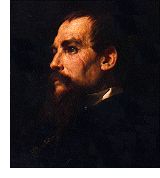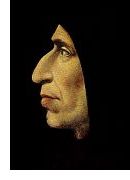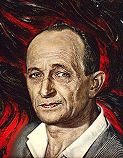
Feature Archive |
| Scandale: The Salons | |
| Revenge: Artimesia Gentileschi | |
| Sittings from Hell: Sargent/Carnation, Lily, Lily, Rose | |
| Private Commissions: Khalil Bey | |
| Rejected Portraits: Kahlo/The Suicide of Dorothy Hale | |
| Villains: Fra Bartolommeo/Savonarola | |
| Surprises: Rembrandt |
Many great figures throughout history have been heroes to their countrymen but symbols of conquest and death to their enemies. The portraits of those that remain symbols of evil have a special kind of fascination for us: How was the subject viewed by his or her contemporaries? How did the artist handle the subject? Is the face that of a hero, a scoundrel or an everyman?
 Sir Richard Francis Burton, the 19th-century explorer of Africa and the Near East, enjoyed (in every sense) a reputation as a great and dangerous villain. He seems far from evil from a modern vantage point, but against the conservative backdrop of Victorian Britain he cultivated an image as an atheist, a hard-as-nails soldier and explorer, and a sexual adventurer. He was also the subject of a remarkable portrait by Frederic Leighton.
Sir Richard Francis Burton, the 19th-century explorer of Africa and the Near East, enjoyed (in every sense) a reputation as a great and dangerous villain. He seems far from evil from a modern vantage point, but against the conservative backdrop of Victorian Britain he cultivated an image as an atheist, a hard-as-nails soldier and explorer, and a sexual adventurer. He was also the subject of a remarkable portrait by Frederic Leighton.Leighton's Portrait of Sir Richard Francis Burton (1872-75) shows the explorer as deeply scarred, and in a solitary darkness. It is fittingly ambiguous about a subject that Britain itself couldn't decide whether to embrace or to shun.
The ultimate villain of our time is Adolf Hitler. The scale of the destruction he wrought is beyond human comprehension, and if you're likely to become upset by a discussion of the horrors of World War II, I strongly urge you to skip right now to the next page, which is a lot more fun.
Salvador Dalí had a bizarre homoerotic fascination with Hitler, which was part of the reason he was ousted from the Surrealist group. He described his obsession to André Parinaud:
I often dreamed of Hitler as a woman. His flesh, which I had imagined whiter than white, ravished me... There was no reason for me to stop telling one and all that to me Hitler embodied the perfect image of the great masochist who would unleash a world war solely for the pleasure of losing and burying himself beneath the rubble of an empire; the gratuitous action par excellence that should indeed have warranted the admiration of the Surrealists.But World War II could be seen coming a long way off, and the political climate had become deadly serious. Not even Dalí was crazy enough to get away with public statements seemingly supporting Franco and Hitler.
Dalí's Hitler paintings, like the rest of his oeuvre, largely defy explanation. They include The Enigma of Hitler, Metamorphosis of the Face of Hitler into a Moonlit Landscape, and (yikes) Hitler Masturbating.
George Grosz was a vocal German critic of Hitler, attacking the rise of National Socialism until he was forced to flee to the United States in 1932. His Cain, or Hitler in Hell (1944) is an apocalyptic landscape in which the victims of fascism crawl up to consume Hitler.
American painter Bernard Safran (1924-1995) created cover portraits for Time Magazine for many years. Among the world leaders he painted were four presidents, the Shah of Iran, and Charles de Gaulle as a Roman emperor (who is said to have been infuriated by the image, and had that week's copies of Time seized in France).
In 1962, Adolf Eichmann, the engineer of Hitler's Final Solution, was whisked away by the Israeli Mossad from Argentina, where he had been living under an assumed name. Safran, a Jew who had fought in the Second World War and who had little reason to be sympathetic to Eichmann, was given the task of painting the monster.
In the portrait, which in the end was never published by Time, Safran treated Eichmann realistically rather than as a grand villain or as a caricature. This proved to be an appropriate approach to the man who later came to symbolize, in Hannah Arendt's term, the "Banality of Evil". Several years ago, I wrote about the Portrait of Adolf Eichmann:
The recent Sensation shows in London and New York provided no shortage of appalling works, including Marcus Harvey's Myra, a portrait of "Moors murderer" Myra Hindley. The huge (9' by 11') painting of Hindley, a widely loathed child-killer in the U.K., was made up of hundreds of children's handprints.
The painting regrettably received loads of media attention for the artist, and was physically attacked at least twice: once it was pelted with eggs and on another occasion it had ink thrown at it. (Harvey's approach to conservation is worth noting: he cleaned the stains off the painting with a scouring pad.)
 Finally, there's more than a trace of unintentional irony in the Portrait of Girolamo Savonarola by the deeply religious Renaissance painter Fra Bartolommeo.
Finally, there's more than a trace of unintentional irony in the Portrait of Girolamo Savonarola by the deeply religious Renaissance painter Fra Bartolommeo.Savonarola was a fanatical monk and self-declared prophet who took control of Florence for four years in the 1490's. He created the original Bonfire of the Vanities, in which countless "lascivious" books and artworks were publicly burned. Savonarola openly challenged the authority of the Vatican, which proved to be a big mistake: he was eventually captured, tortured, hanged, and then burned at the stake for suspicion of heresy.
Fra Bartolommeo was a follower of Savonarola and is said to have destroyed his own paintings in the conflagrations (although the portrait of Savonarola did survive). After Savonarola was overthrown, Bartolommeo entered a monastery and renounced the practice of painting for six years.
So Fra Bartolommeo turned his back on his own art for the sake of Savonarola. When he eventually resumed painting, he must have had Savonarola spinning in his grave when he created an especially vibrant Saint Sebastian - stark naked - for the church of San Marco. Church elders discovered there was a problem when women coming to confession began asking forgiveness for the unholy thoughts the painting inspired, at which point it was removed (and has since been lost).
| Continue to next page: Surprises |
This article is copyright 2000 by John Malyon. Please do not republish any portion of this article without written permission.
John Malyon can be contacted at jmalyon@artcyclopedia.com
